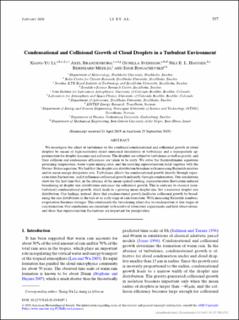| dc.contributor.author | Li, Xiang-Yu | |
| dc.contributor.author | Brandenburg, Axel | |
| dc.contributor.author | Svensson, Gunilla | |
| dc.contributor.author | Haugen, Nils Erland L | |
| dc.contributor.author | Mehlig, Bernhard | |
| dc.contributor.author | Rogachevskii, Igor | |
| dc.date.accessioned | 2021-02-26T07:25:33Z | |
| dc.date.available | 2021-02-26T07:25:33Z | |
| dc.date.created | 2020-09-02T10:59:40Z | |
| dc.date.issued | 2020 | |
| dc.identifier.citation | Journal of the Atmospheric Sciences. 2020, 77 (1), 337-353. | en_US |
| dc.identifier.issn | 0022-4928 | |
| dc.identifier.uri | https://hdl.handle.net/11250/2730532 | |
| dc.description.abstract | We investigate the effect of turbulence on the combined condensational and collisional growth of cloud droplets by means of high-resolution direct numerical simulations of turbulence and a superparticle approximation for droplet dynamics and collisions. The droplets are subject to turbulence as well as gravity, and their collision and coalescence efficiencies are taken to be unity. We solve the thermodynamic equations governing temperature, water vapor mixing ratio, and the resulting supersaturation fields together with the Navier–Stokes equation. We find that the droplet size distribution broadens with increasing Reynolds number and/or mean energy dissipation rate. Turbulence affects the condensational growth directly through supersaturation fluctuations, and it influences collisional growth indirectly through condensation. Our simulations show for the first time that, in the absence of the mean updraft cooling, supersaturation-fluctuation-induced broadening of droplet size distributions enhances the collisional growth. This is contrary to classical (nonturbulent) condensational growth, which leads to a growing mean droplet size, but a narrower droplet size distribution. Our findings, instead, show that condensational growth facilitates collisional growth by broadening the size distribution in the tails at an early stage of rain formation. With increasing Reynolds numbers, evaporation becomes stronger. This counteracts the broadening effect due to condensation at late stages of rain formation. Our conclusions are consistent with results of laboratory experiments and field observations, and show that supersaturation fluctuations are important for precipitation. | en_US |
| dc.language.iso | eng | en_US |
| dc.publisher | American Meteorological Society | en_US |
| dc.title | Condensational and Collisional Growth of Cloud Droplets in a Turbulent Environment | en_US |
| dc.type | Peer reviewed | en_US |
| dc.type | Journal article | en_US |
| dc.description.version | publishedVersion | en_US |
| dc.source.pagenumber | 337-353 | en_US |
| dc.source.volume | 77 | en_US |
| dc.source.journal | Journal of the Atmospheric Sciences | en_US |
| dc.source.issue | 1 | en_US |
| dc.identifier.doi | 10.1175/JAS-D-19-0107.1 | |
| dc.identifier.cristin | 1826666 | |
| dc.relation.project | Notur/NorStore: NN9405K | en_US |
| dc.relation.project | Norges forskningsråd: 267916 | en_US |
| dc.relation.project | Norges forskningsråd: 231444 | en_US |
| cristin.ispublished | true | |
| cristin.fulltext | original | |
| cristin.qualitycode | 2 | |
